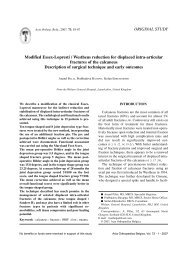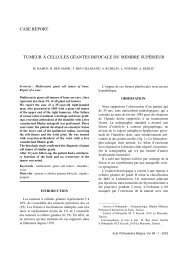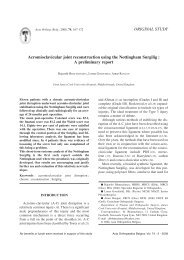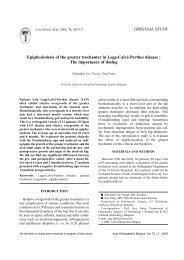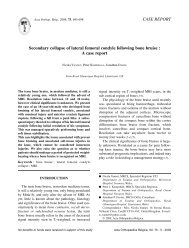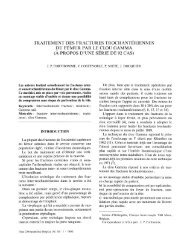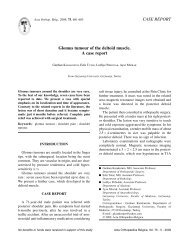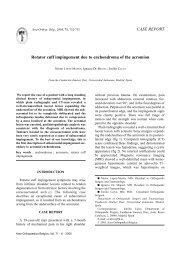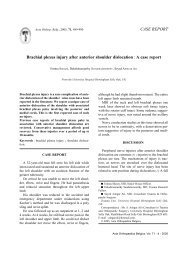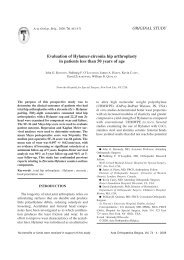Functional reconstruction of the upper extremity in tetraplegia ...
Functional reconstruction of the upper extremity in tetraplegia ...
Functional reconstruction of the upper extremity in tetraplegia ...
Create successful ePaper yourself
Turn your PDF publications into a flip-book with our unique Google optimized e-Paper software.
542 D. WELRAEDS, A. A. ISMAIL, A. PARENT<br />
2.4. Möberg + FDP tenodesis : 1 case<br />
Preoperatively : weak thumb, <strong>in</strong>dex and major<br />
flexion weak, annular and auricular : good flexion.<br />
Postoperatively : good key grip, improved flexion<br />
<strong>of</strong> long f<strong>in</strong>gers.<br />
3. Bilateral comb<strong>in</strong>ed procedures (5 patients, 17<br />
procedures, 16 sessions)<br />
These five cases were submitted to 17 surgical<br />
procedures, each directed toward one function.<br />
Complications (see tables) occurred <strong>in</strong> seven cases<br />
and had to be corrected surgically <strong>in</strong> four cases.<br />
Möberg’s procedure was performed simultaneously<br />
with ECRL or brachioradialis transfer on <strong>the</strong><br />
FDP <strong>in</strong> 3 cases.<br />
4. Results analysis<br />
These results were recorded after corrective procedures<br />
if any and distributed after group<strong>in</strong>g <strong>the</strong><br />
procedures <strong>in</strong> classes.<br />
The result were categorised as good : when a<br />
useful function was obta<strong>in</strong>ed, fair when function<br />
was partially rega<strong>in</strong>ed and poor with a m<strong>in</strong>imal<br />
functional ga<strong>in</strong>.<br />
Atypical procedures (2) good : 2<br />
M ö b e rg pro c e d u res (18) go o d : 17 (fig 3),<br />
poor : 1<br />
Deltoid/triceps (12) good : 7 (fig 4), fair 3,<br />
poor : 2<br />
Additional procedures (11) good : 7, fair : 3,<br />
poor : 1<br />
DISCUSSION<br />
The surgical approach to management <strong>of</strong> hand<br />
paralysis has a long track record : Möberg (10)<br />
quotes attempts made <strong>in</strong> Germany <strong>in</strong> 1920 by<br />
Schmidt and Schrauder.<br />
In 1938, Royle (19) described a technique <strong>of</strong><br />
restoration <strong>of</strong> thumb opposition <strong>in</strong> case <strong>of</strong> palsy <strong>of</strong><br />
<strong>the</strong> <strong>in</strong>tr<strong>in</strong>sic muscles <strong>of</strong> <strong>the</strong> thumb, us<strong>in</strong>g tendon<br />
“re-rout<strong>in</strong>g”.<br />
Sterl<strong>in</strong>g Bunnell (3) laid out <strong>the</strong> major pr<strong>in</strong>ciples<br />
<strong>of</strong> tendon transfer : proximal jo<strong>in</strong>t stabilisation,<br />
release <strong>of</strong> contra c t u res and fi xed defo rm i t i e s ,<br />
Fig. 3. — Result <strong>of</strong> Möberg’s procedure<br />
adequate strength and amplitude for <strong>the</strong> transferred<br />
muscle, straightforward tendon pull, respect <strong>of</strong><br />
muscular function <strong>in</strong>tegrity (except for pronator<br />
teres and brachioradialis).<br />
In 1974, Zancolli (21) suggested an <strong>in</strong>genious<br />
technique to correct <strong>the</strong> claw deformity result<strong>in</strong>g<br />
from <strong>the</strong> <strong>in</strong>tr<strong>in</strong>sic paralysis : <strong>the</strong> lasso operation,<br />
us<strong>in</strong>g a tenodesis <strong>of</strong> FDS to suppress <strong>the</strong> hyperextension<br />
<strong>of</strong> <strong>the</strong> first phalanx.<br />
Lipscomb (13) po<strong>in</strong>ted out that all sp<strong>in</strong>al cord<br />
lesions between <strong>the</strong> 6th and <strong>the</strong> 7th cervical vertebrae<br />
show complete paralysis <strong>of</strong> all f<strong>in</strong>ger muscles<br />
<strong>in</strong>clud<strong>in</strong>g <strong>the</strong> <strong>in</strong>tr<strong>in</strong>sics. Although we had some<br />
lesions at this level, we did not encounter claw<strong>in</strong>g.<br />
Evolution <strong>in</strong> operative techniques<br />
Various surgical techniques were proposed. All<br />
rely on three basis surgical pr<strong>in</strong>ciples :<br />
– tenodesis <strong>of</strong> wrist extensors to restore f<strong>in</strong>ger<br />
flexion, when active extension is available,<br />
– transfer <strong>of</strong> functional muscles belong<strong>in</strong>g to a<br />
synergistic group to a paralysed muscle,<br />
– a rt h rodesis or capsulodesis <strong>of</strong> certa<strong>in</strong> jo<strong>in</strong>ts<br />
(metacarpophalangeal <strong>of</strong> 1 st ray) to obta<strong>in</strong> stabilisation.<br />
Four major events have <strong>in</strong>fluenced <strong>reconstruction</strong><br />
<strong>in</strong> <strong>tetraplegia</strong> :<br />
Acta Orthopædica Belgica, Vol. 69 -6-2003



